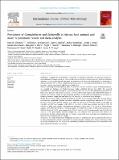| dc.description.abstract | Background: Campylobacter and Salmonella, particularly non-typhoidal Salmonella, are important bacterial en-
teric pathogens of humans which are often carried asymptomatically in animal reservoirs. Bacterial foodborne
infections, including those derived from meat, are associated with illness and death globally but the burden is
disproportionately high in Africa. Commercial meat production is increasing and intensifying in many African
countries, creating opportunities and threats for food safety.
Methods: Following Preferred Reporting Items for Systematic Reviews and Meta-analyses (PRISMA) guidelines,
we searched six databases for English language studies published through June 2016, that reported
Campylobacter or Salmonella carriage or infection prevalence in food animals and contamination prevalence in
food animal products from African countries. A random effects meta-analysis and multivariable logistic re-
gression were used to estimate the species-specific prevalence of Salmonella and Campylobacter and assess re-
lationships between sample type and region and the detection or isolation of either pathogen.
Results: Seventy-three studies reporting Campylobacter and 187 studies reporting Salmonella across 27 African
countries were represented. Adjusted prevalence calculations estimate Campylobacter detection in 37.7% (95%
CI 31.6–44.3) of 11,828 poultry samples; 24.6% (95% CI 18.0–32.7) of 1975 pig samples; 17.8% (95% CI
12.6–24.5) of 2907 goat samples; 12.6% (95% CI 8.4–18.5) of 2382 sheep samples; and 12.3% (95% CI
9.5–15.8) of 6545 cattle samples. Salmonella were detected in 13.9% (95% CI 11.7–16.4) of 25,430 poultry
samples; 13.1% (95% CI 9.3–18.3) of 5467 pig samples; 9.3% (95% CI 7.2–12.1) of 2988 camel samples; 5.3%
(95% CI 4.0–6.8) of 72,292 cattle samples; 4.8% (95% CI 3.6–6.3) of 11,335 sheep samples; and 3.4% (95% CI
2.2–5.2) of 4904 goat samples. ‘External’ samples (e.g. hide, feathers) were significantly more likely to be
contaminated by both pathogens than ‘gut’ (e.g. faeces, cloaca) while meat and organs were significantly less
likely to be contaminated than gut samples.
Conclusions: This study demonstrated widespread prevalence of Campylobacter species and Salmonella serovars
in African food animals and meat, particularly in samples of poultry and pig origin. Source attribution studies
could help ascertain which food animals are contributing to human campylobacteriosis and salmonellosis and
direct potential food safety interventions. | en_US |

